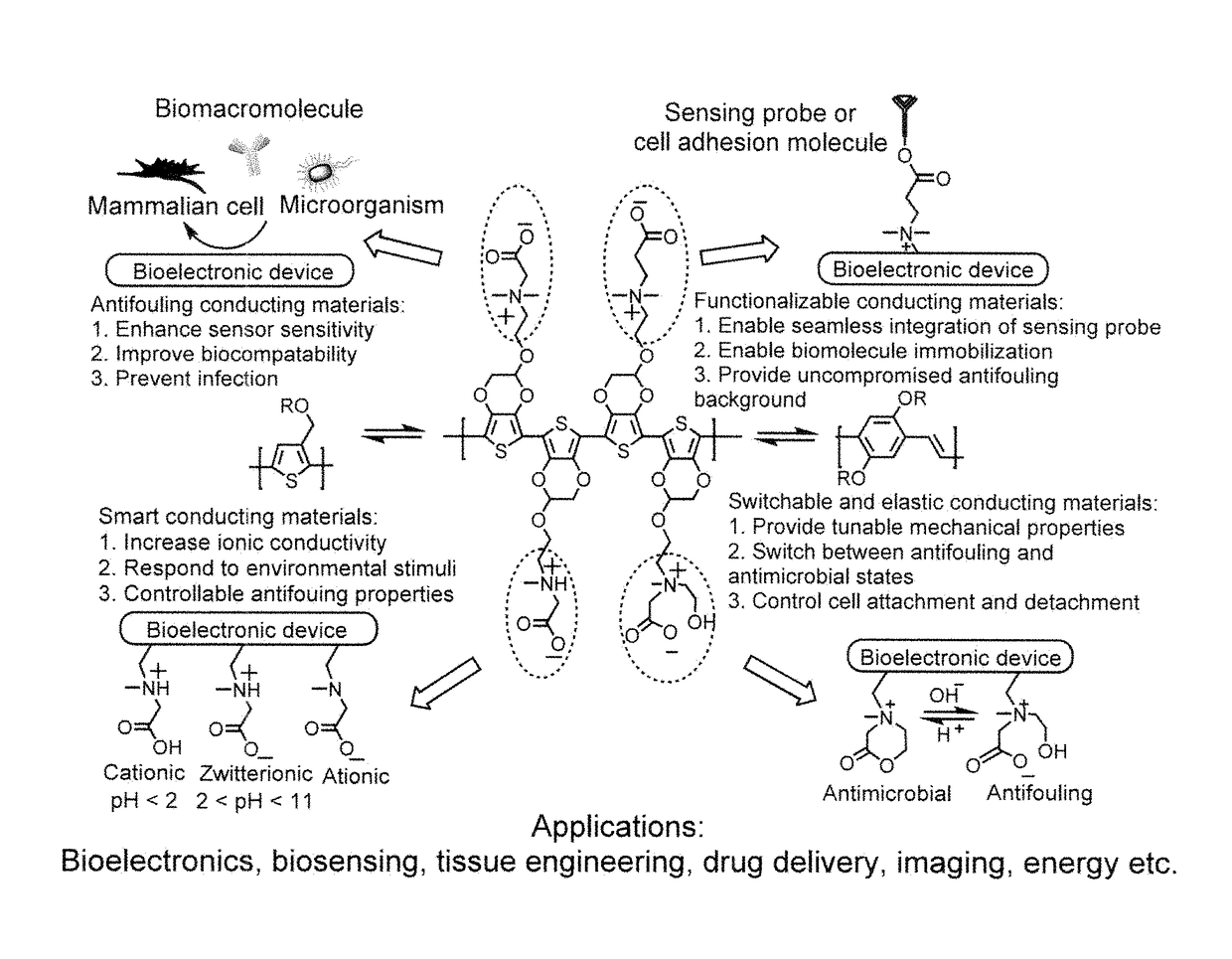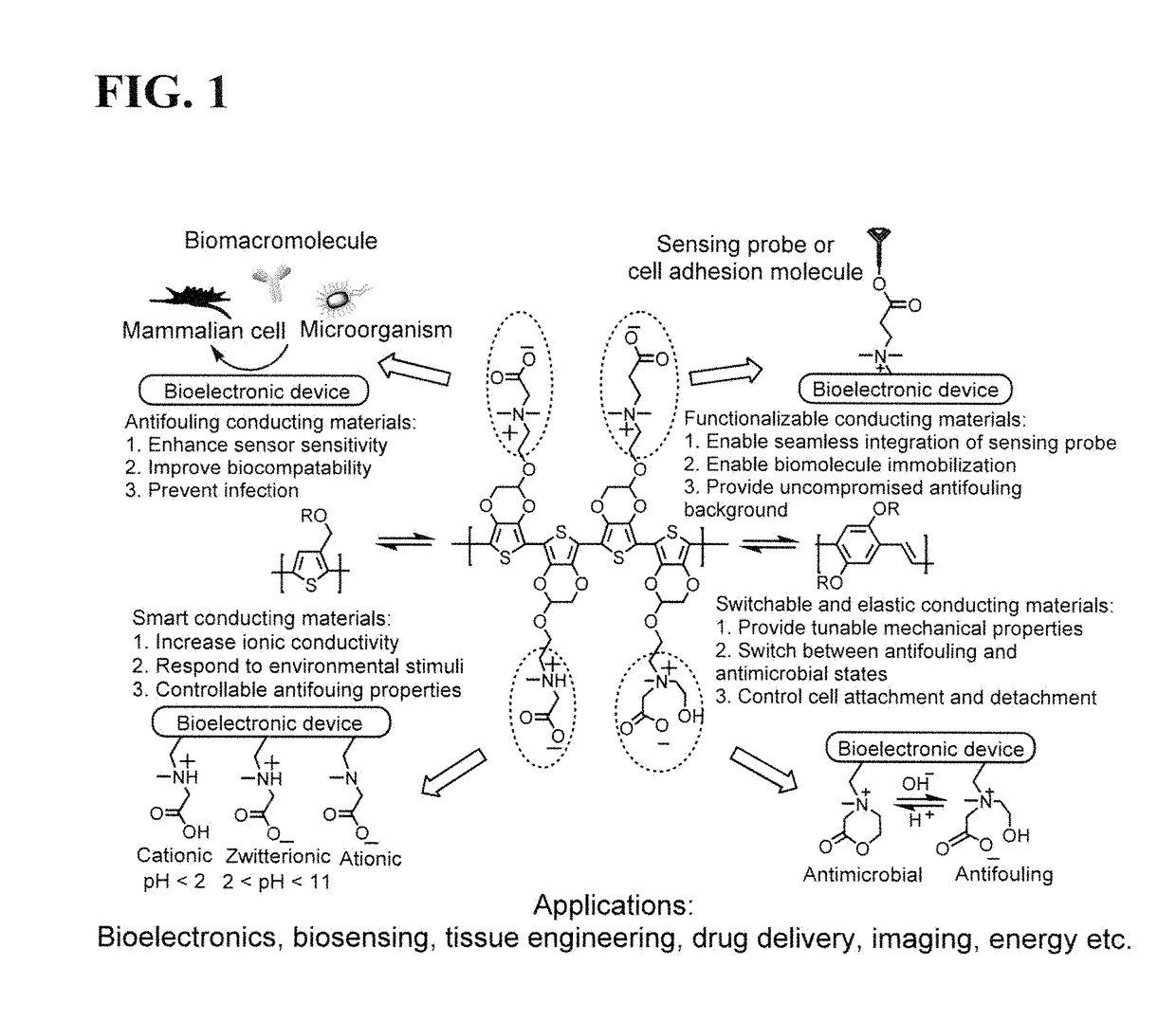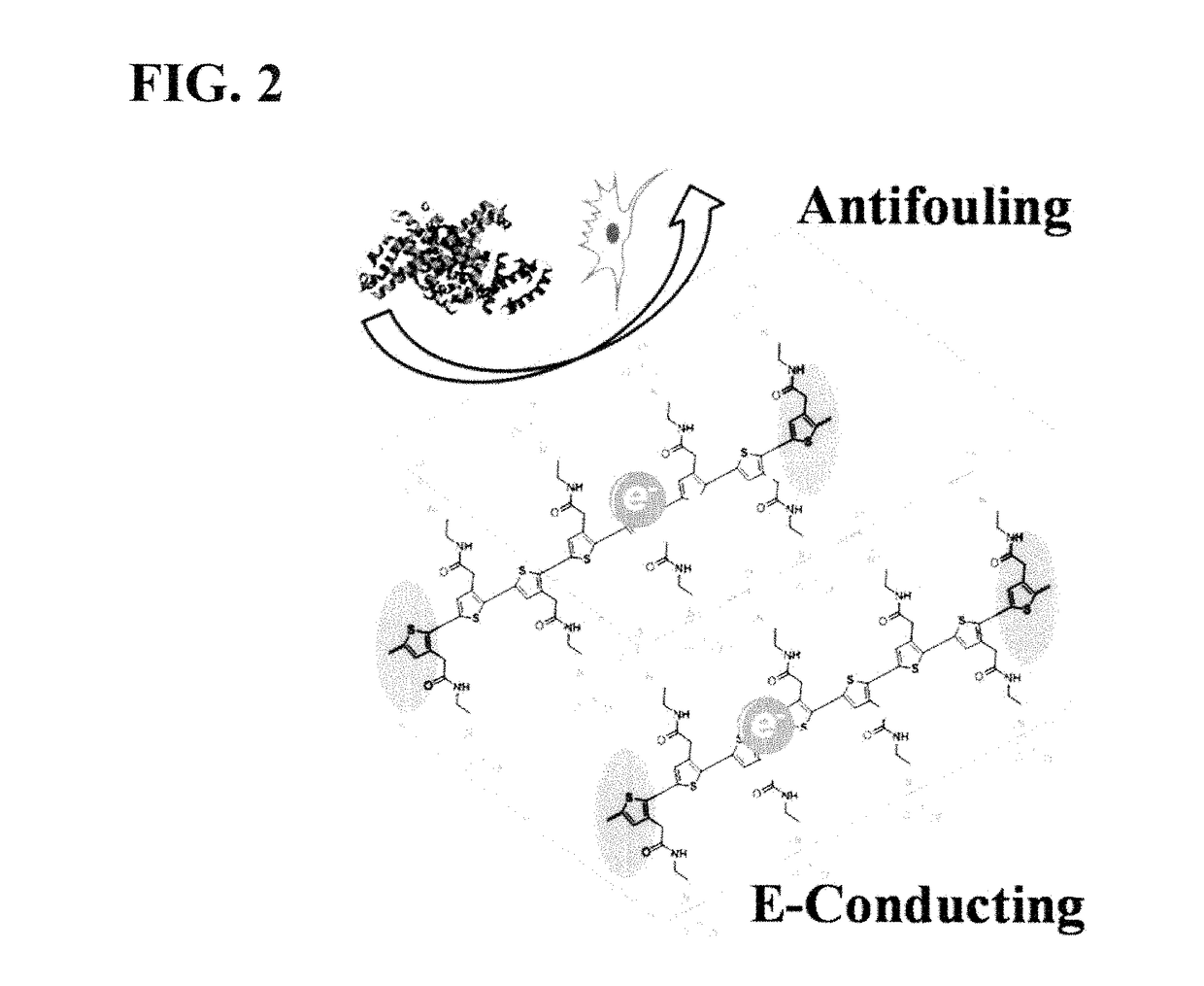Integrated zwitterionic conjugated polymers for bioelectronics, biosensing, regenerative medicine, and energy applications
a conjugated polymer and bioelectronic technology, applied in the field of zwitterionic conjugated polymers, can solve the problems of limiting the utility of addressing a broader range of challenges, reducing the sensitivity and performance of devices, and failure of implanted devices, so as to improve the biocompatibility of cps, enhance electrical conductivity, and improve the effect of antifouling properties
- Summary
- Abstract
- Description
- Claims
- Application Information
AI Technical Summary
Benefits of technology
Problems solved by technology
Method used
Image
Examples
example 1
Synthesis of N-(2-(dimethylamino)ethyl)-2-(thiophen-3-yl)acetamide (LXXXIII)(M2)
[0218]3-Thiopheneacetic acid (4.26 g, 30 mmol) was dissolved in 100 mL of anhydrous THF in a three-necked round bottom flask, followed by the addition of 5.88 g (36 mmol) of 1,1′-Carbonyldiimidazole (CDI). The mixture was cooled in an ice-bath (0° C.) and kept stirring for 20 minutes under a positive nitrogen flow. 3.28 mL of N,N′-dimethylethylenediamine (30 mmol) diluted in 10 mL of anhydrous THF was added drop wise with a dropping funnel. After the complete of addition, the mixture was warmed up to room temperature and kept stirring overnight. THF was removed with a rotary evaporator, and the product was purified with silica gel column chromatography (MeOH / CH2Cl2 / ethyl acetate, 1 / 10 / 10 (v / v / v)). Pure product was obtained as a light yellowish liquid at 67% yield. 1H NMR (300 MHz, CDCl3) δ7.31 (m, 1H), 7.15 (s, 1H), 7.02 (d, 1H, J=4.8 Hz), 6.14 (s, 1H), 3.58 (s, 2H), 3.30 (m, 2H), 2.37 (t, 2H, J=6.0 Hz),...
example 2
Synthesis of methyl thiophene-3-acetate (LXXXIV) (M3)
[0219]Methyl thiophene-3-acetate LXXXTV (M3) was synthesized following the method reported by Kim, L. Chen, Gong, Y. Osada, Macromolecules 1999, 32, 3964-3969, the disclosure of which is incorporated herein by reference in its entirety. Briefly, 3-Thiopheneacetic acid (8.52 g, 60 mmol) was dissolved in 50 mL of methanol with 2 drops of concentrated H2SO4. The mixture was heated in an oil bath and refluxed for 24 hours. After the removal of methanol, the crude product was re-dissolved in diethylether, washed with DI water and dried with anhydrous magnesium sulfate. Pure product was obtained after filtration and evaporation of solvent. The structure was analyzed and confirmed with 1H NMR spectroscopy.
example 3
Synthesis of Homo-Polymer LXXXIV (P1)
[0220]6.11 g (37.7 mmole) of anhydrous FeCl3 was suspended in 60 ml of anhydrous chloroform under a positive nitrogen flow. The mixture was cooled in an ice-bath (0° C.) and kept agitated for 30 minutes. 2.0 g (9.42 mmol) of compound 2 dissolved in 30 mL of dry chloroform was slowly added into the mixture during a period of one hour. Then the reaction was stirred for 24 hours at room temperature under nitrogen. After the reaction, the product was washed with chloroform and dried with rotary evaporator. Then it was re-dissolved in DI-water and purified through dialysis with cellulose dialysis membrane (1 k cut off). Water was changed daily for a week, and the solution was lyophilized to obtain compound LXXXIV (P1) at 20% yield. 1H NMR (300 MHz, D2O) δ 6.6-7.6 (m, thiophene ring proton, 1H), 3.0-4.3 (m, thiophene ring —CH2— and —NH—CH2—, 4H), 2.7-3.0 (m, —CH2—N(CH3)2, 2H), 2.0-2.7 (s, —CH3, 6H) (FIG. 15).
PUM
| Property | Measurement | Unit |
|---|---|---|
| pH | aaaaa | aaaaa |
| electrical conductivity | aaaaa | aaaaa |
| concentration | aaaaa | aaaaa |
Abstract
Description
Claims
Application Information
 Login to View More
Login to View More - R&D
- Intellectual Property
- Life Sciences
- Materials
- Tech Scout
- Unparalleled Data Quality
- Higher Quality Content
- 60% Fewer Hallucinations
Browse by: Latest US Patents, China's latest patents, Technical Efficacy Thesaurus, Application Domain, Technology Topic, Popular Technical Reports.
© 2025 PatSnap. All rights reserved.Legal|Privacy policy|Modern Slavery Act Transparency Statement|Sitemap|About US| Contact US: help@patsnap.com



